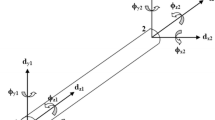Abstract
Recently, more research have been conducted on the analysis of the vibration response of rotors, so that new techniques, which are used to characterize the dynamic response of rotating machines, have been developed to aid and predict the lifespan of such systems. One of the vibration management techniques in rotating systems is the monitoring of stiffness and damping parameters of the bearings and system excitation forces. In this context, this paper aims to estimate the stiffness and damping of the bearings through a hybrid metaheuristic method. This uses a population-based search method as a starting point for direct search method, genetic algorithms and quasi-Newton method, respectively, in this work. The function to be minimized contains experimental bearing data. Moreover, the state observer is used to reconstruct all states of the system from the experimental data from the sensors. Thus, it is proposed to identify the excitation forces using orthogonal functions, Chebyshev polynomials specifically, and then, to verify the effectiveness of the method when compared to the calculated force excitation of the system.











Similar content being viewed by others
Abbreviations
- [A]:
-
Dynamic matrix
- [B]:
-
Input matrix
- [C]:
-
Damping matrix
- [D s ]:
-
Output matrix
- [D me ]:
-
Measurement matrix
- e :
-
Distance between the center and the unbalanced mass
- [F], [X]:
-
Force and displacement coefficient to Chebyshev polynomials
- [G]:
-
Gyroscopic matrix
- [I]:
-
Identity matrix
- J :
-
Cost function
- [L ob ]:
-
Gain matrix of the observer
- m o :
-
Unbalanced mass
- [M]:
-
Mass matrix
- [P]:
-
Operational matrix of integration
- r :
-
Number of terms of Chebyshev polynomials
- δ :
-
Nodal displacement vector for an element
- Ω:
-
Angular velocity
References
Castro HF, Cavalca KL, Camargo LWF, Bachschmid N (2010) Identification of unbalance forces by metaheuristic search algorithms. Mech Syst Signal Process 24:1785–1798
Ford JA, Saadallah AF (1987) On the construction of minimization methods of quasi-Newton type. J Comput Appl Math 20:239–246
Lalanne M, Ferraris G (1997) Rotor dynamics prediction in engineering. 2.ed. John Wiley and Sons, 254p
Luenberger DG (1964) Observing the state of a linear system. IEEE Transactions on Military Ele. Piscataway 8:74–80
Martínez JM (2000) Practical quasi-Newton methods for solving nonlinear systems. J Comput Appl Math 124:97–121
Melo GP, Morais TS (2007) Fault detection using state observers with unknown input, identified by orthogonal functions and PI observers. Solid Mech Struct 1:341–356
Mohamed G et al (2012) Optimal vibration control for structural-acoustic coupling system. J Vib Control 19:14–29
Pacheco RP, Júnior VS (2003) On the identification of non-linear mechanical systems using orthogonal functions. Int J Non-linear Mech 39:1147–1159
Shanno DF (1970) Conditioning of quasi-Newton methods for function minimization. Math Comput 24:647–656
Simões RC, Júnior VS (2003) Optimization techniques for fault identification in rotor dymanics. In: 17th International Congress of Mechanical Engineering, São Paulo, Brazil
Xiaopeng J, Long G, Zhiquan W (2008) Identification of one class of distributed parameter systems based on Chebyshev polynomials. In: 27th Chinese Control Conference, Kunming, China
Zhang J et al (2015) Fault diagnosis approach for rotating machinery based on dynamic model and computational intelligence. Measurement 59:73–87
Acknowledgments
The authors thank INCT and CAPES for the financial support and the Department of Engineering Mechanics of Ilha Solteira for technical support.
Author information
Authors and Affiliations
Corresponding author
Additional information
Technical Editor: Kátia Lucchesi Cavalca Dedini.
Rights and permissions
About this article
Cite this article
de Oliveira, L.R., de Melo, G.P. Experimental determination of stiffness and damping in rotating systems using metaheuristic hybrid optimization and state observers. J Braz. Soc. Mech. Sci. Eng. 38, 59–66 (2016). https://doi.org/10.1007/s40430-015-0413-6
Received:
Accepted:
Published:
Issue Date:
DOI: https://doi.org/10.1007/s40430-015-0413-6




